大学英语语法-介词
- 格式:doc
- 大小:105.00 KB
- 文档页数:6
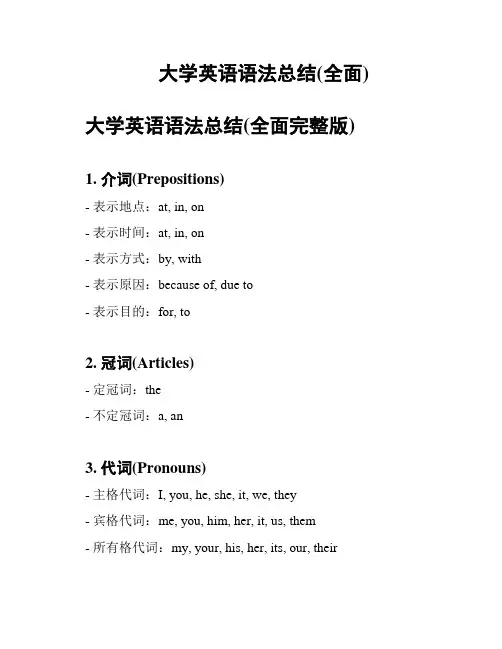
大学英语语法总结(全面)大学英语语法总结(全面完整版)1. 介词(Prepositions)- 表示地点:at, in, on- 表示时间:at, in, on- 表示方式:by, with- 表示原因:because of, due to- 表示目的:for, to2. 冠词(Articles)- 定冠词:the- 不定冠词:a, an3. 代词(Pronouns)- 主格代词:I, you, he, she, it, we, they- 宾格代词:me, you, him, her, it, us, them- 所有格代词:my, your, his, her, its, our, their- 反身代词:myself, yourself, himself, herself, itself, ourselves, themselves4. 名词(Nouns)- 单数名词:book, chair, dog- 复数名词:books, chairs, dogs- 不可数名词:water, money, information5. 动词(Verbs)- 一般现在时:I walk, you walk, he/she/it walks, we walk, they walk- 一般过去时:I walked, you walked, he/she/it walked, we walked, they walked- 现在进行时:I am walking, you are walking, he/she/it is walking, we are walking, they are walking- 过去进行时:I was walking, you were walking, he/she/it was walking, we were walking, they were walking- 一般将来时:I will walk, you will walk, he/she/it will walk, we will walk, they will walk6. 形容词(Adjectives)- 描述名词特征:big, small, tall- 比较级:bigger, smaller, taller- 最高级:biggest, smallest, tallest7. 副词(Adverbs)- 表示方式:quickly, slowly- 表示程度:very, extremely- 表示时间:now, yesterday8. 连词(Conjunctions)- 表并列:and, or- 表递进:furthermore, moreover- 表转折:however, but- 表原因:because, since以上是大学英语语法的简要总结,希望对你有帮助。
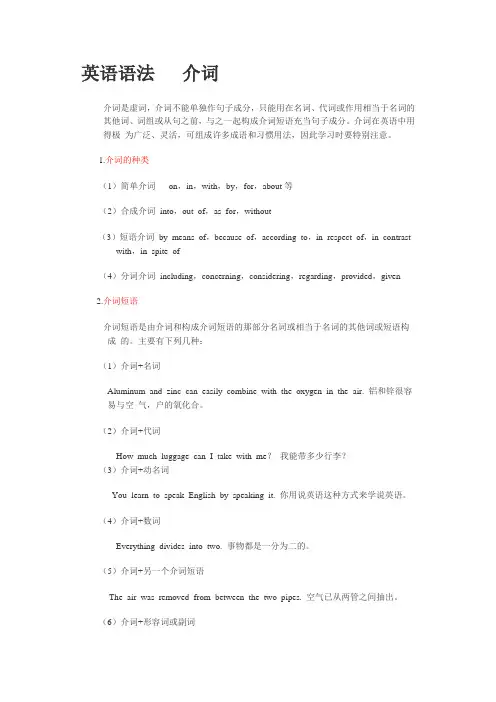
英语语法介词介词是虚词,介词不能单独作句子成分,只能用在名词、代词或作用相当于名词的其他词、词组或从句之前,与之一起构成介词短语充当句子成分。
介词在英语中用得极为广泛、灵活,可组成许多成语和习惯用法,因此学习时要特别注意。
1.介词的种类(1)简单介词on,in,with,by,for,about等(2)合成介词into,out of,as for,without(3)短语介词by means of,because of,according to,in respect of,in contrast with,in spite of(4)分词介词including,concerning,considering,regarding,provided,given2.介词短语介词短语是由介词和构成介词短语的那部分名词或相当于名词的其他词或短语构成的。
主要有下列几种:(1)介词+名词Aluminum and zinc can easily combine with the oxygen in the air. 铝和锌很容易与空气,户的氧化合。
(2)介词+代词How much luggage can I take with me?我能带多少行李?(3)介词+动名词You learn to speak English by speaking it. 你用说英语这种方式来学说英语。
(4)介词+数词Everything divides into two. 事物都是一分为二的。
(5)介词+另一个介词短语The air was removed from between the two pipes. 空气已从两管之间抽出。
(6)介词+形容词或副词It is far from satisfactory.We have made some progress,but it is far from enough.我们已经取得了一些进步,但还远远不够。
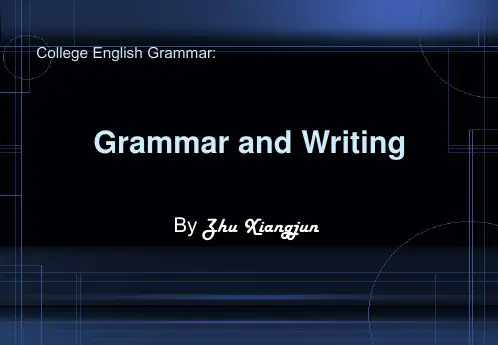
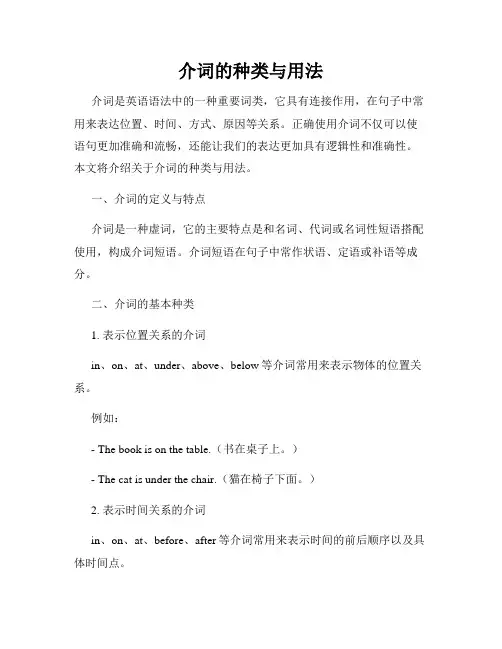
介词的种类与用法介词是英语语法中的一种重要词类,它具有连接作用,在句子中常用来表达位置、时间、方式、原因等关系。
正确使用介词不仅可以使语句更加准确和流畅,还能让我们的表达更加具有逻辑性和准确性。
本文将介绍关于介词的种类与用法。
一、介词的定义与特点介词是一种虚词,它的主要特点是和名词、代词或名词性短语搭配使用,构成介词短语。
介词短语在句子中常作状语、定语或补语等成分。
二、介词的基本种类1. 表示位置关系的介词in、on、at、under、above、below等介词常用来表示物体的位置关系。
例如:- The book is on the table.(书在桌子上。
)- The cat is under the chair.(猫在椅子下面。
)2. 表示时间关系的介词in、on、at、before、after等介词常用来表示时间的前后顺序以及具体时间点。
例如:- I will go shopping in the morning.(我上午去购物。
)- They arrived at the airport on time.(他们准时到达机场。
)3. 表示方式关系的介词by、with、like、as等介词常用来表示行为方式或者比较对象。
例如:- She drew a picture with a pencil.(她用铅笔画了一幅画。
)- He speaks English like a native speaker.(他讲英语像个母语者。
)4. 表示原因关系的介词because of、due to等介词常用来表示某个事物的原因。
例如:- The match was cancelled due to heavy rain.(比赛因为大雨被取消。
)- He failed the exam because of laziness.(他因为懒惰而考试不及格。
)三、介词的常用搭配与固定搭配介词搭配是介词的重要用法之一,掌握了常用的介词搭配能够提高语言表达的准确性。

英语介词知识点归纳1. In: 用于表示在一些位置或范围内。
例如:in the park, in the house.2. On: 用于表示在一些表面上。
例如:on the table, on the wall.3. At: 用于表示在一些地点。
例如:at the bus stop, at the park.5. To: 表示目的地。
例如:to the beach, to the park.6. By: 表示交通工具或方式。
例如:by train, by bus.7. With: 表示伴随或使用。
例如:with my friend, with a pen.8. For: 表示目的或用途。
例如:for a party, for studying.9. About: 表示关于一些主题。
例如:about the movie, about the book.10. Over: 表示在一些区域上方。
例如:over the bridge, overthe sky.11. Under: 表示在一些区域下方。
例如:under the table, under the bed.12. Through: 穿过一些空间或经历一些过程。
例如:through the door, through the forest.13. Withou: 表示没有一些东西或情况。
例如:without a hat, without a doubt.14. Above: 表示在物之上。
例如:above the clouds, above the sign.15. Below: 表示在物之下。
例如:below the surface, below the line.。

介词连词知识点总结归纳一、介词的基本概念介词(Prepositions)是一种词类,它通常用来连接名词、代词、动名词或从句等成分,表示时间、地点、方向、原因、目的等关系。
英语中常见的介词有:on, in, at, to, for, with, by, from, into, out of, between, among, through等。
1. 表示时间关系的介词on:表示某一天、日期、时间点等。
in:表示较长的时间段,季节、年代等。
at:表示具体的时间点、场所、节日等。
例句:I will meet you at the corner of the street at 3 o'clock.I was born in 1990.She always goes to school on foot.2. 表示地点关系的介词in:表示某个大的范围或容器内。
on:表示某个平面或表面上。
at:表示某个具体点或目标。
例句:The book is in the drawer.There is a cat on the roof.She is waiting at the bus stop.3. 表示方向关系的介词to:表示朝着某个目标或方向。
from:表示从某个地点或方向出发。
into:表示朝着某个范围或内部。
例句:He walked to the park.I come from China.She poured the water into the glass.4. 表示原因和目的的介词for:表示给予或用于某种目的。
with:表示陪伴或使用某种手段。
例句:I bought a gift for my friend.She cut the cake with a knife.5. 表示关系的介词between:表示在两者或多者之间的关系。
among:表示在多个之中的关系。
through:表示穿过或通过某个范围。
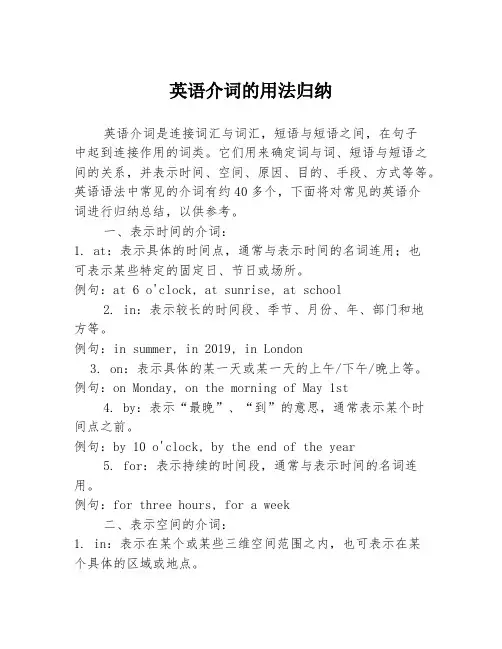
英语介词的用法归纳英语介词是连接词汇与词汇,短语与短语之间,在句子中起到连接作用的词类。
它们用来确定词与词、短语与短语之间的关系,并表示时间、空间、原因、目的、手段、方式等等。
英语语法中常见的介词有约40多个,下面将对常见的英语介词进行归纳总结,以供参考。
一、表示时间的介词:1. at:表示具体的时间点,通常与表示时间的名词连用;也可表示某些特定的固定日、节日或场所。
例句:at 6 o'clock, at sunrise, at school2. in:表示较长的时间段、季节、月份、年、部门和地方等。
例句:in summer, in 2019, in London3. on:表示具体的某一天或某一天的上午/下午/晚上等。
例句:on Monday, on the morning of May 1st4. by:表示“最晚”、“到”的意思,通常表示某个时间点之前。
例句:by 10 o'clock, by the end of the year5. for:表示持续的时间段,通常与表示时间的名词连用。
例句:for three hours, for a week二、表示空间的介词:1. in:表示在某个或某些三维空间范围之内,也可表示在某个具体的区域或地点。
例句:in the room, in the park2. on:表示在某个平面面上,通常用来表示地点。
例句:on the table, on the wall3. at:表示在某个具体的地点或位置。
例句:at the door, at the bus stop4. by:表示“靠近”、“经过”等含义。
例句:by the river, by the window5. between:表示在两个或两个以上的物体或位置之间。
例句:between two mountains, between the buildings6. among:表示在三个或三个以上的物体或位置之间。
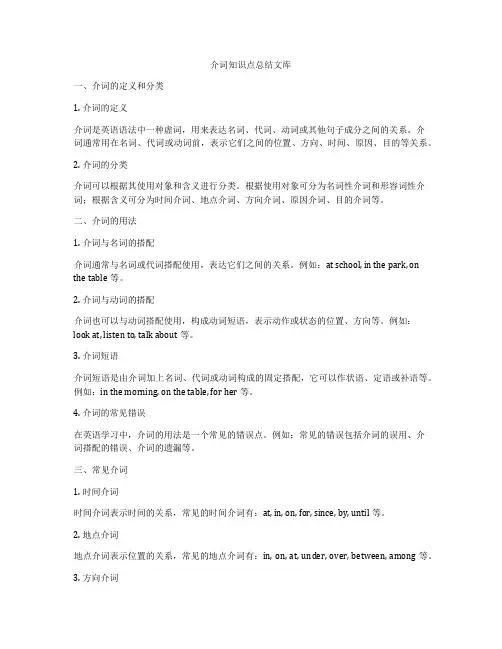
介词知识点总结文库一、介词的定义和分类1. 介词的定义介词是英语语法中一种虚词,用来表达名词、代词、动词或其他句子成分之间的关系。
介词通常用在名词、代词或动词前,表示它们之间的位置、方向、时间、原因、目的等关系。
2. 介词的分类介词可以根据其使用对象和含义进行分类。
根据使用对象可分为名词性介词和形容词性介词;根据含义可分为时间介词、地点介词、方向介词、原因介词、目的介词等。
二、介词的用法1. 介词与名词的搭配介词通常与名词或代词搭配使用,表达它们之间的关系。
例如:at school, in the park, on the table等。
2. 介词与动词的搭配介词也可以与动词搭配使用,构成动词短语,表示动作或状态的位置、方向等。
例如:look at, listen to, talk about等。
3. 介词短语介词短语是由介词加上名词、代词或动词构成的固定搭配,它可以作状语、定语或补语等。
例如:in the morning, on the table, for her等。
4. 介词的常见错误在英语学习中,介词的用法是一个常见的错误点。
例如:常见的错误包括介词的误用、介词搭配的错误、介词的遗漏等。
三、常见介词1. 时间介词时间介词表示时间的关系,常见的时间介词有:at, in, on, for, since, by, until等。
2. 地点介词地点介词表示位置的关系,常见的地点介词有:in, on, at, under, over, between, among等。
3. 方向介词方向介词表示方向的关系,常见的方向介词有:to, from, into, out of, through, across等。
4. 原因介词原因介词表示原因的关系,常见的原因介词有:because of, due to, owing to等。
5. 目的介词目的介词表示目的的关系,常见的目的介词有:for, to, in order to, so as to等。
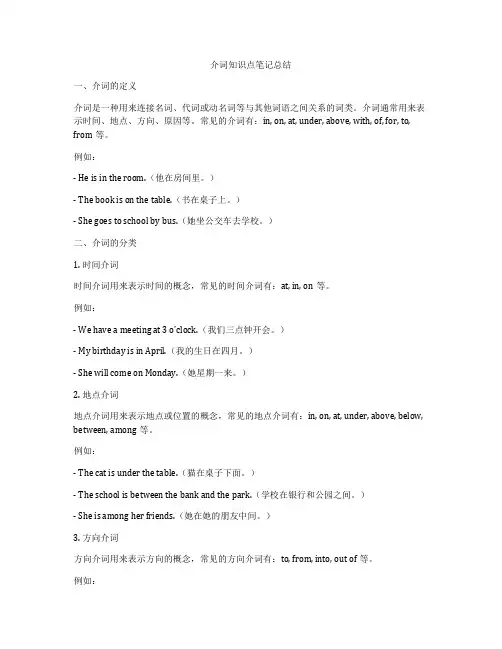
介词知识点笔记总结一、介词的定义介词是一种用来连接名词、代词或动名词等与其他词语之间关系的词类。
介词通常用来表示时间、地点、方向、原因等。
常见的介词有:in, on, at, under, above, with, of, for, to, from等。
例如:- He is in the room.(他在房间里。
)- The book is on the table.(书在桌子上。
)- She goes to school by bus.(她坐公交车去学校。
)二、介词的分类1. 时间介词时间介词用来表示时间的概念,常见的时间介词有:at, in, on等。
例如:- We have a meeting at 3 o’clock.(我们三点钟开会。
)- My birthday is in April.(我的生日在四月。
)- She will come on Monday.(她星期一来。
)2. 地点介词地点介词用来表示地点或位置的概念,常见的地点介词有:in, on, at, under, above, below, between, among等。
例如:- The cat is under the table.(猫在桌子下面。
)- The school is between the bank and the park.(学校在银行和公园之间。
)- She is among her friends.(她在她的朋友中间。
)3. 方向介词方向介词用来表示方向的概念,常见的方向介词有:to, from, into, out of等。
例如:- She goes to school by bike.(她骑自行车去学校。
)- He comes from China.(他来自中国。
)- The cat jumps into the box.(猫跳进箱子里。
)4. 原因介词原因介词用来表示原因或目的的概念,常见的原因介词有:for, because of, due to等。
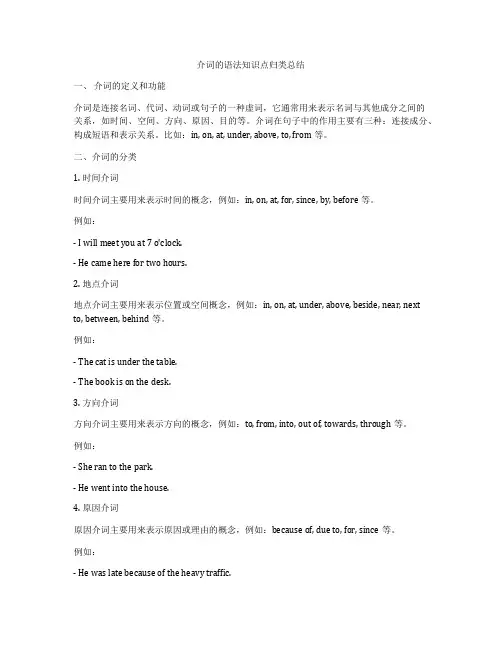
介词的语法知识点归类总结一、介词的定义和功能介词是连接名词、代词、动词或句子的一种虚词,它通常用来表示名词与其他成分之间的关系,如时间、空间、方向、原因、目的等。
介词在句子中的作用主要有三种:连接成分、构成短语和表示关系。
比如:in, on, at, under, above, to, from等。
二、介词的分类1. 时间介词时间介词主要用来表示时间的概念,例如:in, on, at, for, since, by, before等。
例如:- I will meet you at 7 o'clock.- He came here for two hours.2. 地点介词地点介词主要用来表示位置或空间概念,例如:in, on, at, under, above, beside, near, next to, between, behind等。
例如:- The cat is under the table.- The book is on the desk.3. 方向介词方向介词主要用来表示方向的概念,例如:to, from, into, out of, towards, through等。
例如:- She ran to the park.- He went into the house.4. 原因介词原因介词主要用来表示原因或理由的概念,例如:because of, due to, for, since等。
例如:- He was late because of the heavy traffic.目的介词主要用来表示目的或目标的概念,例如:for, to, in order to等。
例如:- I went to the supermarket for some food.6. 介词短语介词短语是由介词加上它的宾语构成,用来修饰名词或代词。
例如:in front of, in the middle of, in the end, on the way等。
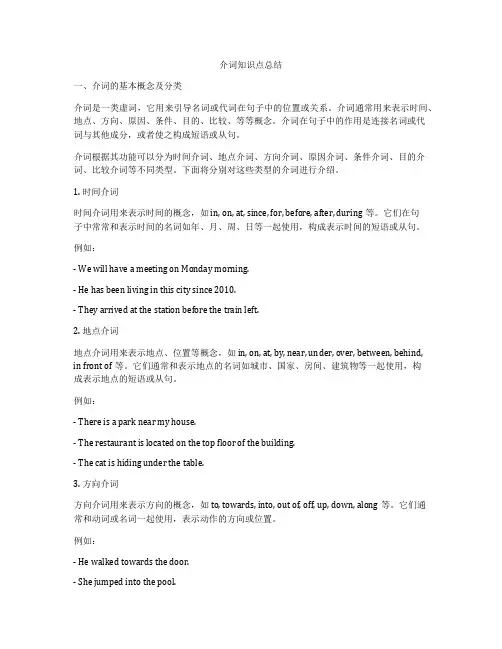
介词知识点总结一、介词的基本概念及分类介词是一类虚词,它用来引导名词或代词在句子中的位置或关系。
介词通常用来表示时间、地点、方向、原因、条件、目的、比较、等等概念。
介词在句子中的作用是连接名词或代词与其他成分,或者使之构成短语或从句。
介词根据其功能可以分为时间介词、地点介词、方向介词、原因介词、条件介词、目的介词、比较介词等不同类型。
下面将分别对这些类型的介词进行介绍。
1. 时间介词时间介词用来表示时间的概念,如 in, on, at, since, for, before, after, during等。
它们在句子中常常和表示时间的名词如年、月、周、日等一起使用,构成表示时间的短语或从句。
例如:- We will have a meeting on Monday morning.- He has been living in this city since 2010.- They arrived at the station before the train left.2. 地点介词地点介词用来表示地点、位置等概念,如 in, on, at, by, near, under, over, between, behind,in front of等。
它们通常和表示地点的名词如城市、国家、房间、建筑物等一起使用,构成表示地点的短语或从句。
例如:- There is a park near my house.- The restaurant is located on the top floor of the building.- The cat is hiding under the table.3. 方向介词方向介词用来表示方向的概念,如 to, towards, into, out of, off, up, down, along等。
它们通常和动词或名词一起使用,表示动作的方向或位置。
例如:- He walked towards the door.- She jumped into the pool.- The bird flew up into the sky.4. 原因介词原因介词用来表示原因的概念,如 because of, due to, owing to, thanks to等。
第四讲介词一、分类1 . 简单介词指由一个单词构成的介词, 简单介词也可能由形容词、副词、名词、连词等转变而来, 常用的有:by, in, after , on, at , past , since, till , until , over, opposite, off, near , of, with, up, under, toward( s) , through , like, from, for , down , during, except , but , beyond,between ,besides, beside, beneath, below, behind, before, among, along, against , above, across ,about , amid( st) , onto, underneath , unlike, round, next , despite, than, save 除⋯⋯之外, 等。
2 . 以-ing 结尾的介词这类介词由现在分词演变而来, 常用的有:excepting 除⋯⋯外, including 包括, regarding 关于, barring 除⋯⋯外, concerning 关于, touching 关于, considering 就⋯⋯而言, saving 除外, respecting 关于, pending 在⋯⋯之中(到⋯⋯为止) , failing 如果没有(若无⋯⋯时) , following 在⋯⋯以后, 等。
3 . 合成介词into 进入, outside 在⋯⋯外, within 在⋯⋯内, without 没有, throughout 遍及(贯穿) ,inside 在⋯⋯内, upon 在⋯⋯上, alongside 在⋯⋯旁边(沿着) , notwithstanding 虽然,等。
4 . 短语介词这类介词是短语性的固定介词搭配, 可以是介词+ 名词, 介词+ 介词, 介词+ 分词, 介词+ 动词, 介词+ 形容词, 介词+ 副词等构成, 常用的有:out of 从⋯⋯里面(从⋯⋯中) , but for 要不是, ahead of 在⋯⋯前, according to 根据,apar t from 除⋯⋯外, along with 同⋯⋯一起, because of 由于(因为) , together with 同⋯⋯一起, as regards 关于, as to 关于(至于) , due to 由于, in front of 在⋯⋯前面, in place of 代替, on behalf of 代表, near to 靠近, instead of 替代(而不) , next to 紧靠旁边(贴近) , on account of 由于(鉴于) , owing to 由于(因为) , with regard to 关于, in regard to 关于, prior to 在⋯⋯前, in view of 考虑到, in spite of 尽管, in accordance with 根据,by means of 用(依靠) , as f rom 自⋯⋯起, as for 至于, apar t from 除⋯⋯外(若无) , except for 除⋯⋯外, as concerns 关于, as compared with 同⋯⋯相比, for want of 因为缺乏, at the cost of 以⋯⋯为代价, over against 在⋯⋯对面(正对着) , down to 下至( 直至) , away from 离开, irrespective of 不顾, with a view to 旨在(目的是) , on the point of正要⋯⋯之际, in the event of 如果发生(万一) , for the sake of 为了, by way of 经由(通过) , up to 一直到, thanks to 由于(多亏) , previous to 先于, due to 由于, 等。
英语介词详解
介词在英语中是一种虚词,用于表示名词或代词与句子其他部分之间的关系。
以下是介词的详细解释:
1.定义:介词是用于描述名词或代词与句子其他部分之间关系的词。
它们通常
放在名词或代词之前,表示方向、位置、时间、方式等。
2.功能:介词的主要功能是帮助建立名词或代词与其他句子成分之间的关系,
提供更多的语境和背景信息。
3.常见介词:以下是一些常见的英语介词:at、in、on、by、with、about、
over、before、after、during等。
4.用法:介词的用法非常灵活,需要根据上下文和语境来判断。
例如,在句子
“The book is on the table”中,介词“on”表示“在……上面”;在句子“I will meet you at the train station”中,介词“at”表示“在……
地方”。
5.注意事项:使用介词时需要注意一些常见错误,如多余的介词、缺少介词或
使用不当的介词等。
正确使用介词可以提高英语表达的准确性和流畅性。
介词是英语中一个非常重要的语言元素,正确使用介词可以帮助我们更好地表达思想,建立句子之间的关系,提高语言的质量。
介词英语知识点总结一、介词的基本用法1. 表示位置关系介词常常用来表示名词或代词与其他词之间的空间位置关系,例如:- The book is on the table.- She is sitting next to me.2. 表示时间关系介词也常常用来表示时间关系,例如:- We will meet at 9 o'clock.- He is going to the party on Friday.3. 表示方向关系介词还可以用来表示名词或代词的运动方向,例如:- The bird flew into the sky.- She walked along the river.4. 表示原因、目的、方式等关系有时介词还可以表示名词或代词的原因、目的、方式等关系,例如:- We went to the park for a picnic.- She speaks English with confidence.二、介词的种类介词可以分为时间介词、地点介词、方向介词和其他介词。
1. 时间介词时间介词用来表示时间的概念,如 at, in, on, since, for, during, before, after, etc. - We will have a meeting at 3 o'clock.- She was born in 1990.- They arrived on Monday.2. 地点介词地点介词用来表示地点的概念,如 in, on, at, by, near, under, over, etc.- The cat is in the box.- He put the book on the table.- She is waiting at the bus stop.3. 方向介词方向介词用来表示运动方向的概念,如 into, out of, through, along, towards, etc.- The dog jumped into the water.- She walked out of the room.- They ran towards the beach.4. 其他介词其他介词包括原因、目的、方式等介词,如 for, with, without, by means of, because of, etc.- We are going to the cinema for a movie.- She wrote the letter with a pen.- He won the game by means of hard work.三、介词的常见错误在使用介词的过程中,很容易出现一些错误,下面列举一些常见的介词错误以及正确的使用方式。
大一介词知识点总结在英语语法中,介词是一类常用的词性,用于表示名词之间的关系。
大一学习阶段是初次接触介词的时候,下面将对大一学生常见的介词知识点进行总结。
一、介词的定义和用法介词是一类虚词,它通常位于名词或代词之前,用来引导短语或从句。
介词指示时空关系、方式和目的等,常用于描述地点、时间、方向、比较等概念。
二、常见的介词以下是常见的介词及其主要用法:1. of: 表示所属关系、材料、特点、构成等例:the book of my friend(我的朋友的书)2. in: 表示位置、状态、方式等例:in the classroom(在教室里)3. on:表示位置、状态、方式等例:on the table(在桌子上)4. at: 表示位置、时间、方式等例:at the park(在公园里)5. for: 表示目的、受益人、代替等例:study for the exam(为了考试而学习)6. to: 表示方向、接触等例:go to school(去学校)7. with: 表示伴随、具有等例:go with friends(和朋友一起去)8. by: 表示方式、工具等例:travel by car(乘坐汽车旅行)9. about: 表示关于、大约等例:talk about the movie(谈论电影)10. from: 表示起点、来源等例:receive a gift from my parents(从父母那里收到礼物)三、常见介词搭配除了了解单个介词的用法,还需要掌握一些常见的介词搭配,以便正确运用。
1. in front of: 在...前面例:The car is parked in front of the house.(汽车停在房子前面。
)2. at the end of: 在...的末尾例:We arrived at the end of the road.(我们到达了路的末尾。
)3. on top of: 在...的顶部例:The book is on top of the shelf.(书放在书架的顶部。
大学英语介词用法与辨析大学英语介词用法与辨析导语:到了大学,还要再学介词,但是学的内容比高中时候学得更深入了,词还是那些词,但是就是比较复杂了,下面YJBYS店铺介绍大学英语介词用法与辨析,欢迎参考!一、表示方位的介词:in, to, on1. in 表示在某地范围之内。
如:Shanghai is/lies in the east of China. 上海在中国的东部。
2. to 表示在某地范围之外。
如:Japan is/lies to the east of China. 日本位于中国的东面。
3. on 表示与某地相邻或接壤。
如:Mongolia is/lies on the north of China. 蒙古国位于中国北边。
二、表示计量的介词:at, for, by1. at表示“以……速度”“以……价格”。
如:It flies at about 900 kilometers an hour. 它以每小时900公里的速度飞行。
I sold my car at a high price. 我以高价出售了我的汽车。
2. for表示“用……交换,以……为代价”。
如:He sold his car for 500 dollars. 他以五百元把车卖了。
注意:at表示单价(price) ,for表示总钱数。
3. by表示“以……计”,后跟度量单位。
如:They paid him by the month. 他们按月给他计酬。
Here eggs are sold by weight. 在这里鸡蛋是按重量卖的。
三、表示材料的介词:of, from, in1. of成品仍可看出原料。
如:This box is made of paper. 这个盒子是纸做的。
2. from成品已看不出原料。
如:Wine is made from grapes. 葡萄酒是葡萄酿成的。
3. in表示用某种材料或语言。
如:Please fill in the form in pencil first. 请先用铅笔填写这个表格。